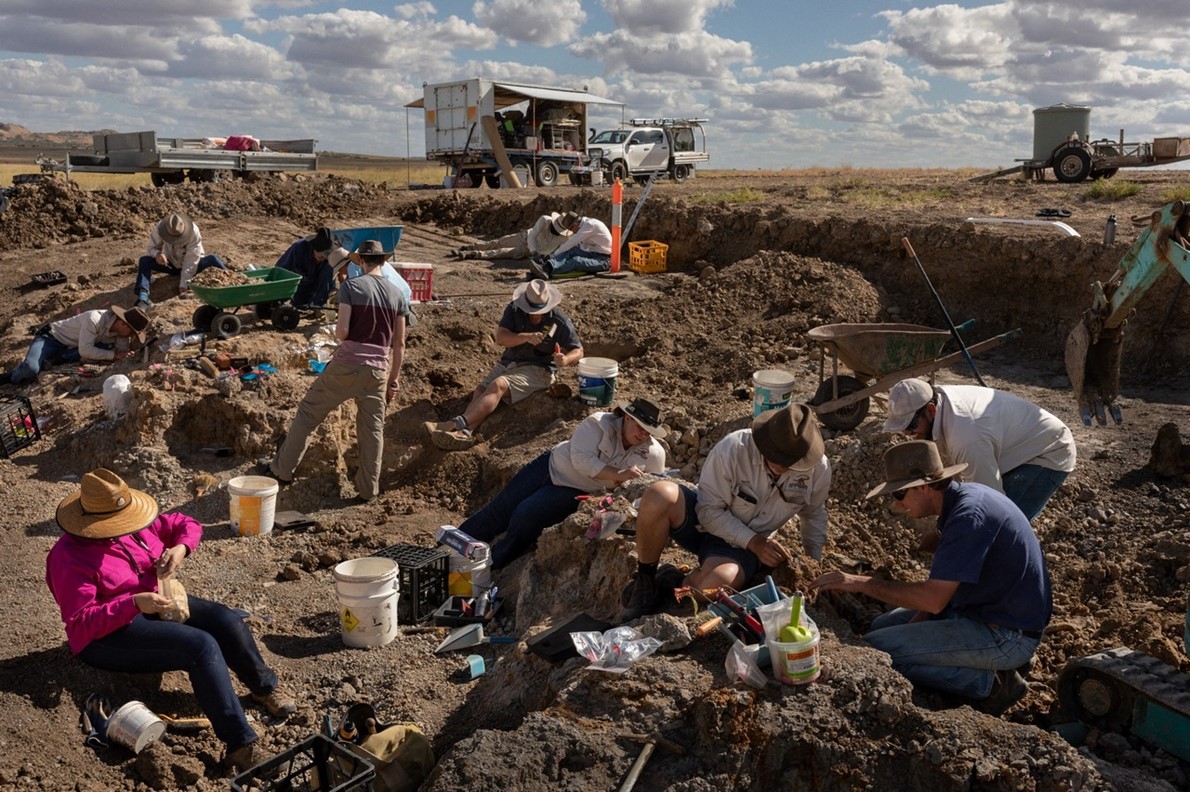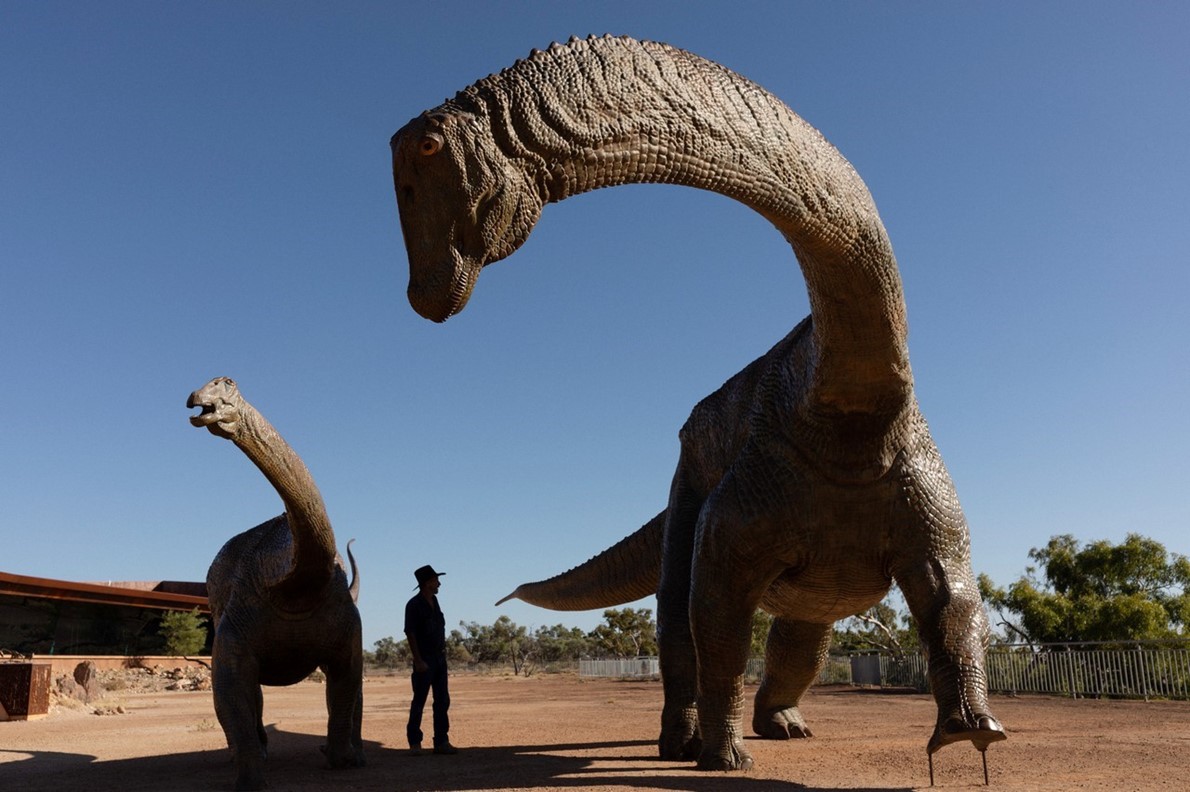WINTON, Australia — It took a moment to spot the fragment, initially:
fist-size and unnaturally smooth, nestled between shrubs teeming with burrs in
an endless expanse of arid plains. But after the first, the others were easier
to pick out, gleaming dirty white against the red earth and run through with a
honeycomb texture.
اضافة اعلان
Dinosaur bones.“They’re bloody everywhere,” marveled Matt Herne, curator of
the Australian Age of Dinosaurs Museum. About an hour’s drive from the town of
Winton, he was inspecting the fossils for the couple who had found them,
farmers whose property stretched as far as the eye could see in all directions.
(The couple requested anonymity, not wanting the attention that would come if
it were known that bones were on their property.)
“It’s spongy bone. Just like a sheared steak bone,” Herne
said. “These fragments are telling us that they’ve probably come up from
something underneath, and it’s probably quite a large animal.”
For as long as paleontologists have been looking, dinosaur
fossils were extraordinarily rare in Australia, and the continent was a missing
piece in scientists’ understanding of dinosaurs globally. But it is now
experiencing a dinosaur boom, with a flurry of discoveries made over the past
two decades that is rewriting the country’s fossil record.
Near-perfect skulls and teeth. A string of new species. Some
of the biggest dinosaurs ever recorded. And many of them have begun with a
farmer, tripping over an unusual-looking rock, in the sparsely populated plains
of outback central west Queensland where sheep outnumber people.
“Before these discoveries started coming out of central
western Queensland, Australian dinosaurs were absolutely, extraordinarily
rare,” said Matt Lamanna, a paleontologist at the Carnegie Museum of Natural
History in Pittsburgh. The paleontological community “collectively assumed that
dinosaurs were really, really hard to find in Australia,” he added.
That all changed, according to scientists, when David
Elliott, a farmer near Winton, came across some fossils on his farm in 1999.
It was not unusual for residents in central west Queensland
to stumble upon ancient remains. Elliott, 66, recalled how his father would
often come home after a day’s work on the family farm with his pockets bulging
with fossils. Once he took over the farm, he also kept one eye on the ground
while mustering his sheep, and eventually collected enough fragments to cover a
pingpong table.

But locals largely kept their findings to themselves,
fearing that publicizing them would bring a flood of scientists, bureaucracy,
and red tape into their lives.
When Elliott decided to contact a paleontologist two years
later, “Everyone said, ‘Oh, mate, they’ll build a national park and take you
over,’” he recalled, adding, “We were very much a test case for the region. No
one else was putting their hand up.”
It was lucky he did, as the resulting excavation upended
paleontologists’ understanding of how to find dinosaur fossils in Australia.
Earlier paleontologists had assumed that small fragments
like those found by Elliott were the last remains of complete fossils that had
been weathered down into nearly nothing over the ages, and now had little
scientific value.
Elliott thought differently. Having lived and worked on the
land all his life, he knew that parts of things deep underground could often be
seen on the surface. He believed that the fragments could be markers pointing
the way to dinosaur graveyards far below the surface.
When the scientists arrived on his property, he got his
excavator and started to dig. His suspicions were confirmed: About 5 feet down,
the earth was teeming with chunks of bone.

“That really is the watershed point,” said Scott Hocknull, a
paleontologist at the Queensland Museum, who was there. Simply by digging down
farther than earlier paleontologists had done, “you transition from not finding
anything to finding everything.”
More discoveries followed on Elliott’s property. He set up
his own museum in a shed, which would later become a nonprofit called the
Australian Age of Dinosaurs. Locals who knew and trusted him started coming to
him with their own findings. Paleontologists started using the same method to
unearth more bones around the region, including of one of the largest dinosaurs
in the world.
A paleo-tourism industry quickly emerged. Paleontologists
who once left the country, believing that the only way to advance their careers
was overseas, flocked back. Dinosaur excavations were organized, where
volunteers exhumed dozens of bones at a time. And for locals in the region, who
had been watching their towns steadily shrink over the decades, wariness began
to turn into a sense of possibility.
One Saturday last month, inside a pit about 5 feet deep,
volunteers — who pay up to 3,700 Australian dollars (or $2,475) each to attend
a one-week dig — were hard at work. Many said they were fulfilling long-held
paleontology aspirations that had once seemed impossible in Australia.
Cheryl Condon, 76, said that this dig was the eighth she had
attended. She said she had always been interested in the prehistoric past, but
never considered it a viable career option when she was young.
“There weren’t dinosaurs in Australia at that point,” she
said. Gesturing at the dozen bones being uncovered around her, she added
jokingly: “I don’t know where these all came from.”
As Elliott watched the ancient past being painstakingly
chipped out of the ground on the same dig, he considered the future.
“You’re thinking about how that’s going to contribute to
your museum and how that museum is trying to fit that to and tell the story of
Australia,” he said. “And the other thing, for me, is keeping regional
Australia alive.”
The sheep industry once thrived in this region, but a
commodities crash and relentless droughts have driven many shearers away. The
population of Winton has nearly halved to a little over 1,100 in the past 20
years, as people have left to seek better prospects elsewhere.
Tourism could be the answer. Elliott’s museum attracted
60,000 people in 2021.
“It’s gone absolutely crazy,” said Kev Fawcett, the owner of
the Winton Hotel. During the pandemic when Australians couldn’t travel
overseas, the winter season got so busy that tourists were sleeping in their
cars, because the town’s three caravan parks and four motels were full. Fawcett
is now renovating the 10 unused rooms in his hotel in anticipation of the next
tourist season.
Elliott wants to expand into Australia’s leading natural
history museum — something that will attract international visitors and that
can benefit not only Winton but the other small towns in regional Queensland.
“Every town has a got a little museum in it, and no one’s
coming from around the world to see that,” he said. “You need to have a major
destination for people.”
For Hocknull, the Queensland Museum paleontologist, the
discoveries they have made so far have only scratched the surface.
“The exciting part for me is not that the boom has happened,
but what will be the outcome of all of this in the next 20 to 40 years,” he
said. “The dinosaurs will continue to be found. Who knows what we’ve got?”
Read more Odd and Bizarre
Jordan News







